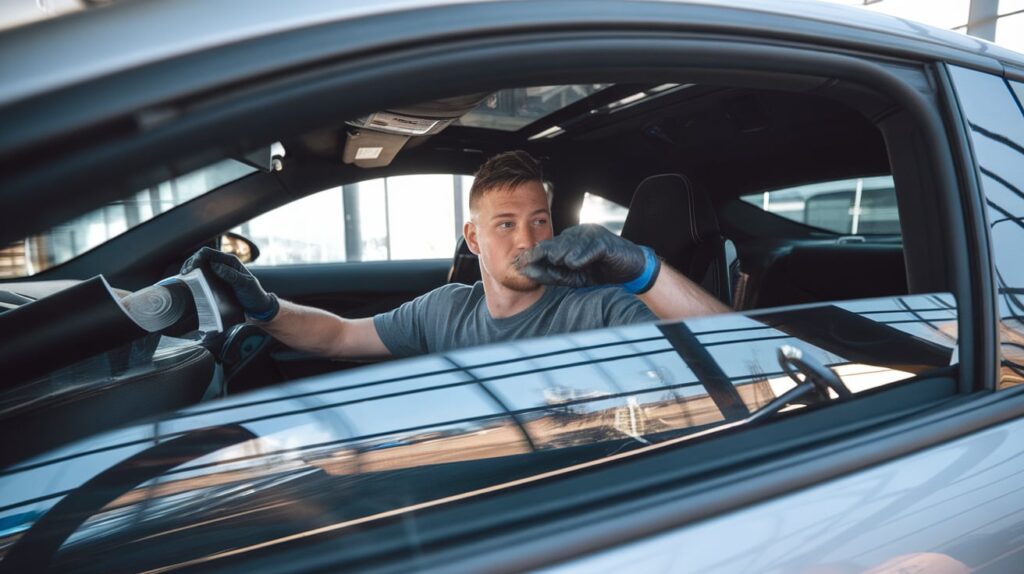In Dubai’s extreme climate, ceramic film tinting isn’t just a style upgrade; it’s essential protection. Unlike standard automotive window tint, nano-ceramic films block infrared heat and harmful UV rays without interfering with GPS, mobile, or radio signals.
This signal-safe tint offers superior heat control and UV protection, keeping interiors cooler and materials from fading. And no, this isn’t a DIY fix. Professional ceramic tinting requires precise tools and expert handling to ensure a flawless application and long-term performance. For luxury vehicles and high-performance cars, ceramic film is the gold standard.
The Science Behind Ceramic Film Tinting | Nano-Tech Meets Performance
At the core of ceramic tinting lies nano-ceramic technology, a breakthrough in window film engineering. Unlike dyed or metallic tints, ceramic films are made from non-metallic particles that are microscopic in size yet powerful in function. These nano-ceramic particles are embedded within multiple layers of the film, creating a dense matrix that filters out infrared (IR) radiation without compromising clarity or signal transmission.
Where dyed films rely on pigments that fade over time, and metallic films reflect heat but interfere with electronics, ceramic tinting offers a smarter solution. It’s non-conductive, non-reflective, and completely signal-safe, ideal for vehicles equipped with GPS, mobile data, and advanced driver-assistance systems.
This high-performance tint excels in IR filtering, blocking up to 90% of infrared heat while maintaining optical clarity. That means cooler cabins, reduced AC load, and preserved interior materials, all without the mirror-like glare of metallic films.
Ceramic film tinting isn’t just about aesthetics; it’s engineered for durability, performance, and compatibility with modern automotive tech. For drivers in high-temperature regions like Dubai, it’s the intelligent choice for long-term comfort and protection.
Ceramic Film Tinting | Real Performance You Can Feel
Ceramic tinting isn’t just hype; it’s backed by hard numbers. Using advanced nano-ceramic particles, this film delivers superior protection and comfort, especially in extreme climates like Dubai.
Heat Reduction
Dubai’s sun can turn your car into an oven. Ceramic tint fights back with powerful infrared filtering.
- Blocks over 50% of infrared (IR) radiation
- Lowers cabin temperature by 10–15°C
- Reduces AC usage, improving fuel efficiency
UV Protection
UV rays damage interiors and skin. Ceramic film acts as a barrier against long-term exposure.
- Filters out 99% of harmful UV rays
- Prevents fading of leather, dashboards, and electronics
- Shield passengers from long-term skin damage
Glare Control & Clarity
Driving should be sharp and comfortable, day or night. Ceramic tint reduces glare without darkening your view.
- Cuts glare from sunlight and headlights
- Maintains optical clarity, no hazy or darkened view
- Ideal for night driving and high-visibility conditions
Signal-Safe Technology
Modern cars rely on connectivity. Ceramic tint protects without blocking signals.
- Non-metallic, non-conductive structure
- No interference with GPS, mobile, or onboard electronics
- Perfect for luxury vehicles with advanced tech
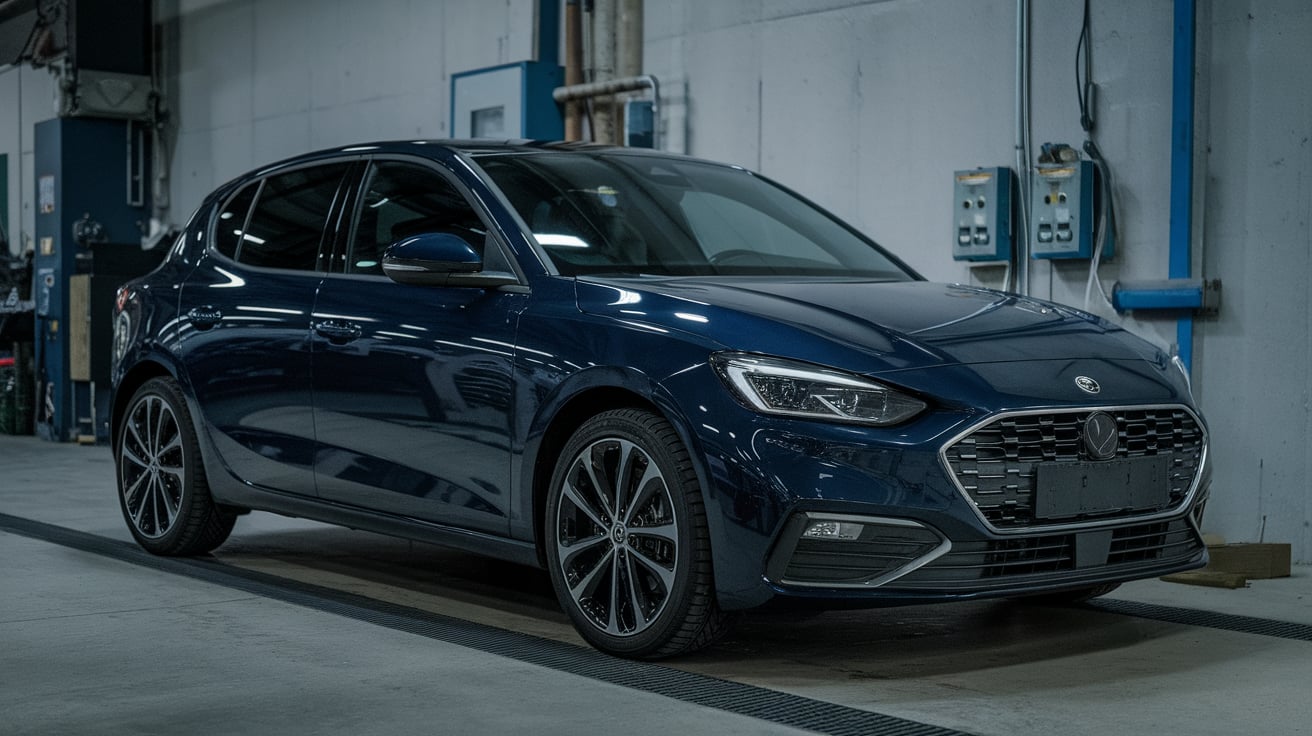
Ceramic Film Tinting | Professional Application Process
Ceramic film tinting isn’t a peel-and-stick job; it’s a precision service performed by trained technicians using specialized tools and clean-room conditions. Every step matters to ensure flawless adhesion, maximum performance, and long-term durability. Here’s how the process unfolds, from prep to final inspection:
Step 1| Pre-Installation Inspection and Preparation
Before any ceramic tinting begins, a thorough pre-installation inspection is essential. This step ensures the glass is ready for optimal tint adhesion and long-term performance.
Technicians start with a detailed glass inspection, checking for chips, scratches, or factory coatings that may interfere with bonding. Any surface damage or incompatible materials are flagged to prevent future defects or peeling.
Next comes surface prep. Using lint-free cloths, alcohol-based cleaners, and contamination-free tools, the glass is cleaned to remove dust, oil, and residue. Even microscopic particles can compromise the film’s clarity and durability.
Edges, seals, and trim are also inspected to ensure no moisture or debris will affect the installation. This meticulous process sets the foundation for flawless ceramic tinting, maximizing film longevity and visual quality. Skipping this step risks bubbles, lifting, and reduced IR/UV performance. In premium workshops, prep is non-negotiable.
Step 2 | Surface Cleaning and Decontamination
Proper cleaning is the backbone of successful ceramic tinting. Even the most advanced nano-ceramic film won’t perform if the glass isn’t perfectly prepped. Technicians use specialized prep solvents, typically alcohol-based or ammonia-free formulas, to dissolve oils, adhesives, and airborne contaminants. These agents ensure maximum film adhesion without leaving streaks or residue.
Lint-free cleaning tools are critical. Microfiber cloths are avoided due to potential shedding and static buildup, which can attract dust during installation. Instead, high-grade squeegees and tack cloths are used to maintain clarity preservation. Edge cleaning is especially important. Dirt and moisture trapped in seals can migrate under the film over time, causing lift or distortion. Every corner, curve, and contour is meticulously cleaned to meet the standards of professional ceramic tinting.
This step isn’t optional; it’s what separates flawless installs from failed ones. In Dubai’s dusty climate, glass prep is everything in ceramic tinting.
Step 3 | Film Cutting and Shaping Techniques
Precision cutting is where ceramic film tinting starts to take shape, literally. Whether using a digital plotter or manual tools, the goal is a precision fit that hugs every curve and contour of the vehicle’s glass.
In high-end workshops, plotter cutting systems are often used to pre-cut nano-ceramic film based on vehicle-specific templates. This ensures consistent sizing, clean edges, and minimal waste. For custom jobs or rare models, hand trimming is still the gold standard, requiring expert control and blade finesse.
Contour matching is critical, especially for luxury vehicles with complex glass shapes. Technicians use heat-forming techniques and edge guides to mold the film without stress or distortion. Poor alignment leads to edge lift, which compromises both aesthetics and performance. Overcuts are avoided at all costs. They not only look sloppy but can also expose adhesive edges to dust and moisture. Every cut is deliberate, clean, and aligned with the seal.
In professional ceramic film tinting, cutting isn’t just about shape; it’s about longevity. A perfect fit means better bonding, cleaner visuals, and zero rework. That’s why top-tier tinting shops treat this step as a craft. Ceramic tinting demands precision, and this is where it begins to show.
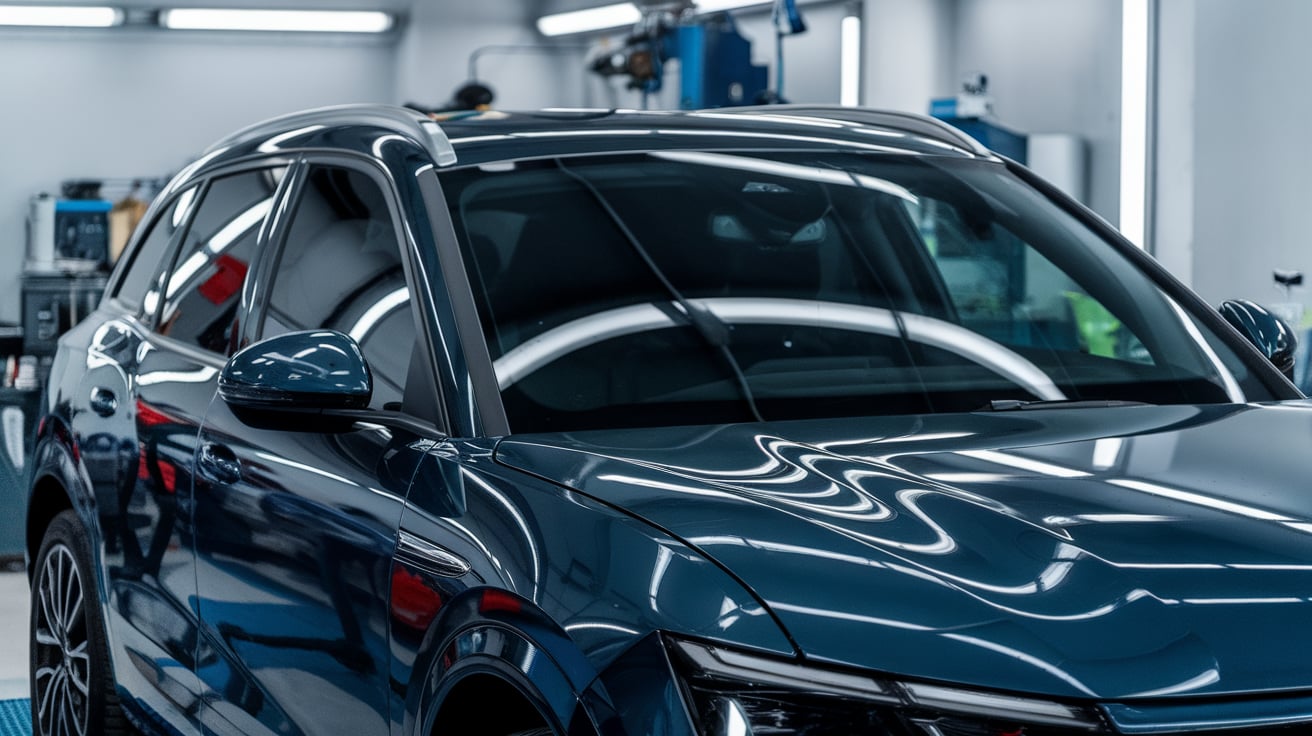
Step 4 | Heat Shrinkage and Molding the Film
Heat shrinking is a critical phase in ceramic tinting, especially when working with curved glass like rear windshields and panoramic roofs. This step ensures the film conforms smoothly to complex surfaces without creases or bubbles.
Technicians use controlled heat gun techniques to activate the film’s memory, allowing it to shrink and mold precisely to the glass curvature. Strategic shrink zones are identified to guide the film’s movement, preventing overstretching or distortion.
Avoiding hotspots is key. Uneven heating can warp the nano-ceramic structure, reducing optical clarity and compromising performance. Skilled installers maintain consistent motion and distance to ensure uniform shrinkage.
For large surfaces like the rear windshield, vertical and horizontal shrinking methods are combined to match compound curves. On panoramic roofs, extra care is taken to avoid stress lines and ensure full edge coverage. This step is where ceramic film tinting truly separates itself from basic tint jobs. The film’s ability to mold without bubbling or lifting depends entirely on precision heat control.
Step 5 | Wet Application Process
The wet application stage is where ceramic film tinting meets precision placement. Using a carefully mixed slip solution, typically a blend of distilled water and baby shampoo or tint-safe soap, technicians create a lubricated surface that allows the film to glide into position without premature adhesion.
Correct slip solution ratios are critical. Too much soap reduces tack; too little causes sticking and creases. Once the film is laid onto the glass, installers use targeted squeegee techniques to remove moisture and air.
Squeegee pressure zones are mapped to avoid stretching or tearing. Stroke patterns vary by glass shape, with vertical strokes for windshields and radial strokes for curved surfaces. The goal is full water displacement without trapping pockets beneath the film.
Edges and corners receive extra attention to prevent lift and ensure a streak-free finish. Any remaining water or bubbles can compromise adhesive activation, leading to long-term defects. In professional ceramic film tinting, this step demands finesse. It’s not just about sticking the film, it’s about bonding it perfectly. With Dubai’s heat accelerating cure times, flawless wet application is essential to long-lasting results in ceramic film tinting.
Step 6 | Final Positioning and Edge Sealing
Once the film is shaped and applied, the final task in ceramic film tinting is securing every edge. This step isn’t cosmetic, it’s structural. If the film lifts, peels, or shifts, the entire job fails.
Technicians use micro-trimming blades to clean up excess material, ensuring the film sits tight against the glass seals. In high-friction zones, like frameless doors or sliding windows, edge sealant may be applied to reinforce the bond and support edge curing.
Corners are pressed and locked with precision tools. This film anchoring prevents movement when windows roll up and down, especially in vehicles with tight tolerances. Without proper sealing, heat and dust can creep under the film, leading to bubbling or detachment. In Dubai’s climate, that risk is real. That’s why professional ceramic film tinting always ends with edge control, because durability starts at the edges.
Step 7 | Curing Time and Post-Installation Care
After ceramic film tinting, the film needs time to settle and bond fully. The curing period typically ranges from 2 to 5 days, depending on humidity, glass type, and exposure to sunlight.
During this time, moisture evaporation may cause temporary haze or small water bubbles. These are normal and will disappear as the film settles. Customers are advised not to touch or press the film during this phase.
Avoid rolling down windows for at least 48 hours. Early movement can disrupt film settling and lead to edge lift. Also, skip any cleaning, especially with chemicals or abrasive cloths, for the first week.
Once cured, the film will deliver full UV protection, heat rejection, and clarity. If haze persists beyond a week or bubbles enlarge, contact the workshop for inspection. Proper post-care ensures the longevity of ceramic film tinting. In Dubai’s heat, letting the film cure undisturbed is key to long-term performance in ceramic film tinting.
For guaranteed results and long-lasting comfort, explore our Car Tinting Services in Dubai. Our experts ensure precision installation, premium films, and aftercare guidance so your tint performs at its best in UAE conditions.
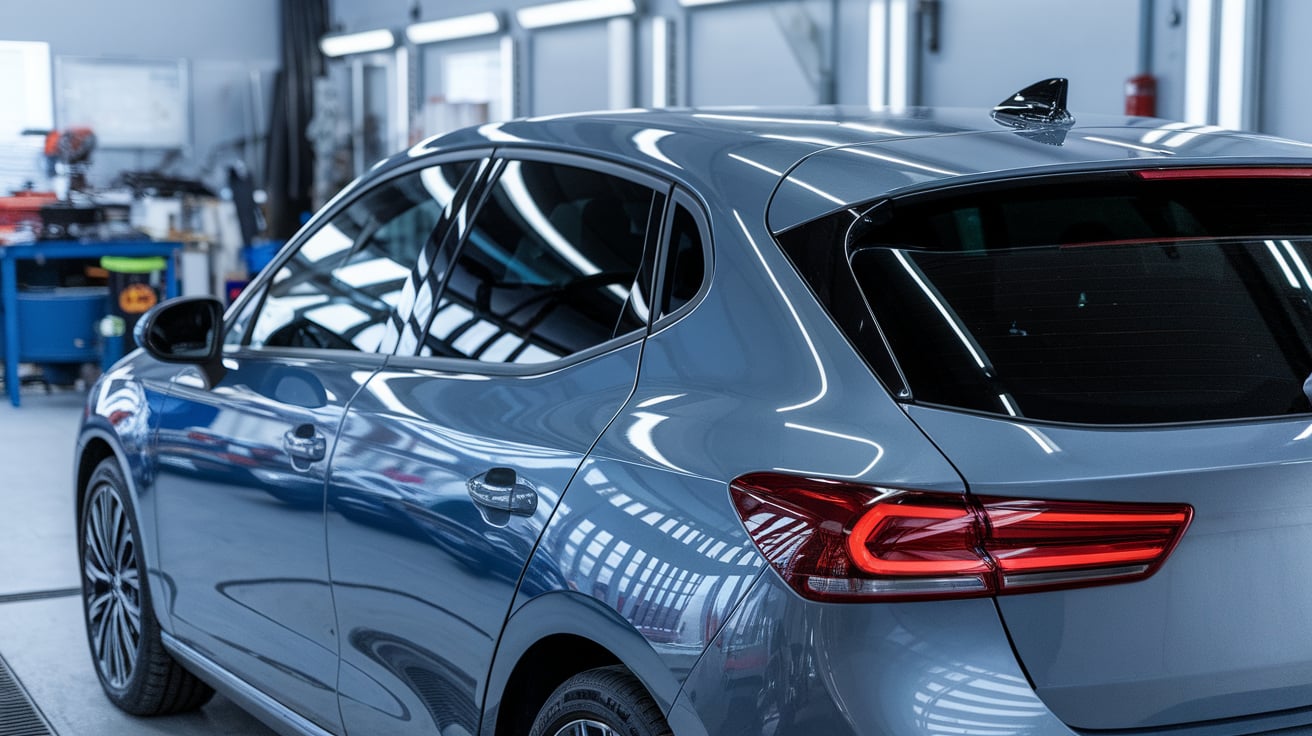
Ceramic Tinting vs Other Tint Types
In Dubai’s relentless heat, ceramic film tinting offers unmatched protection and value. Here’s a breakdown:
| Tint Type | Heat Rejection | UV Protection | Signal Interference | Longevity | Cost (AED) |
| Dyed Film | Low | Moderate | None | Short | 300–500 |
| Carbon Tint | Moderate | High | None | Medium | 450–700 |
| Metallic Film | High | High | Yes | Medium | 500–800 |
| Ceramic Film | Very High | 99%+ | None | Long | 800–1,500 |
Ceramic film tinting uses nano-ceramic particles to block infrared heat and UV rays without affecting GPS or mobile signals. It’s ideal for Dubai’s climate, where temperatures regularly exceed 45°C.
Though it costs more upfront, ceramic tint reduces AC load, improves fuel efficiency, and protects interiors, making it the smartest long-term investment. For luxury vehicles and performance-focused drivers, ceramic film tinting delivers premium comfort and durability.
Legal Compliance and Tinting Regulations
In Dubai, ceramic film tinting must meet strict RTA compliance standards to ensure safety and visibility. The legal limits are:
- Front windshield & front side windows: Minimum 70% Visible Light Transmission (VLT)
- Rear windows & back windshield: Up to 30% tint allowed
Only approved non-reflective films are permitted, and installation must be done by certified professionals. Ceramic films excel here; they offer high UV and heat rejection without compromising visibility or causing signal interference. By meeting visibility laws and avoiding excessive darkness, ceramic tinting ensures full legal protection while delivering premium performance in Dubai’s climate.
For a detailed breakdown of these regulations, check out our full guide on RTA Tint Rules in Dubai. It explains the legal tint percentages, penalties for violations, and how to choose films that pass inspections without sacrificing comfort.
Ceramic Tinting Maintenance Tips
To preserve the clarity and longevity of your ceramic film tinting, follow these care guidelines:
- Use only ammonia-free cleaners; ammonia can degrade the film’s protective layers
- Clean with a soft microfiber cloth to avoid scratches or swirl marks
- Avoid abrasive sponges, paper towels, or harsh chemicals
- Stick to a monthly maintenance schedule, especially after sandstorms or heavy rain
- Never scrape the film with blades or sharp tools
Proper cleaning methods and gentle handling ensure your ceramic tint stays flawless, functional, and UV-protective for years, especially under Dubai’s harsh sun.
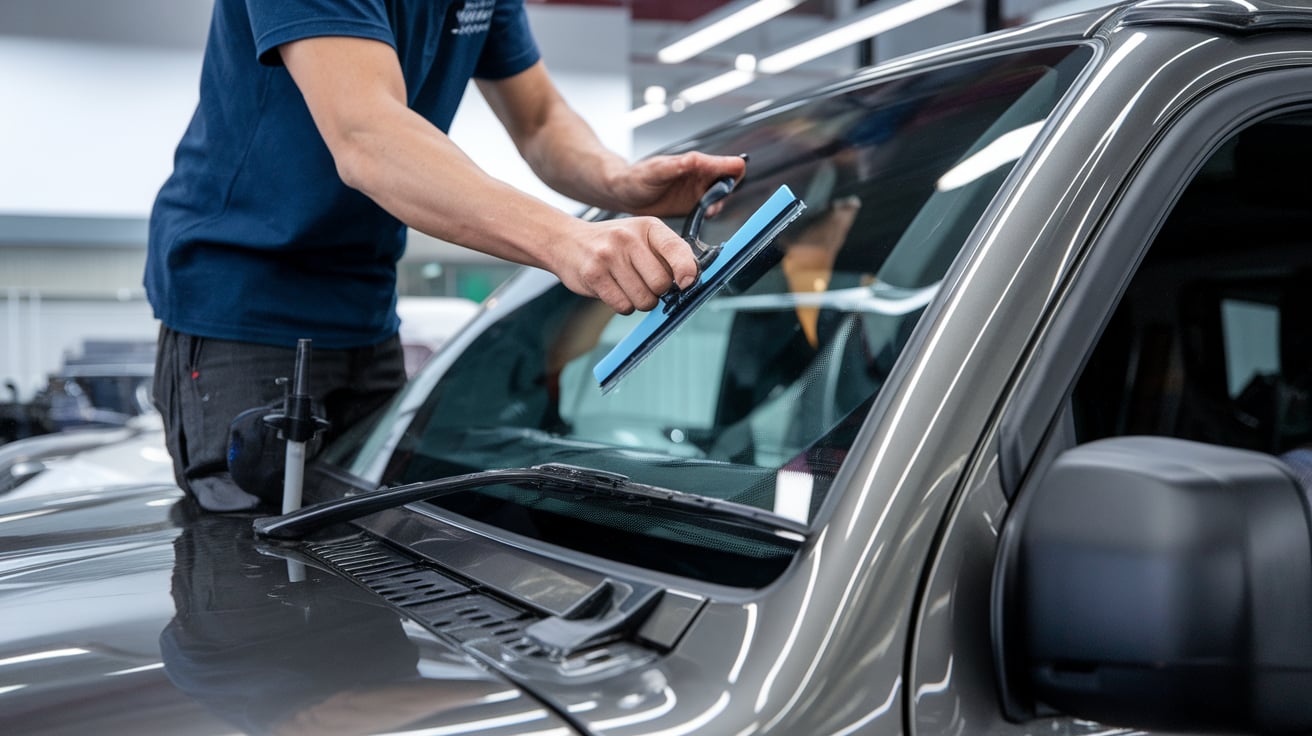
Why Choose Professional Ceramic Film Tinting Services?
Opting for professional ceramic film tinting ensures flawless results and long-term performance. Certified installers use precision tools and controlled environments to apply the film without bubbles, misalignment, or edge lift.
Unlike DIY kits, professional services offer tinting expertise, access to premium-grade films, and proper curing protocols. You also benefit from warranty coverage and a service guarantee, protecting your investment against peeling, fading, or installation errors.
In Dubai’s demanding climate, expert ceramic film tinting delivers superior heat rejection, clarity, and durability. For luxury vehicles and high-performance standards, professional application is not just better, it’s essential.
Drive Cooler, Clearer, & Smarter with Ceramic Film Tinting
In Dubai’s unforgiving heat, ceramic film tinting isn’t just a luxury; it’s a necessity. From unmatched UV protection and heat rejection to legal compliance and long-term durability, ceramic tint delivers performance where it matters most.
Whether you’re protecting a luxury interior, improving driving comfort, or simply investing in smarter vehicle care, choosing certified professionals ensures flawless results backed by expertise and warranty.
Ready to upgrade your ride? Choose ceramic. Choose precision. Choose peace of mind. Book your tinting appointment today, and experience the difference that premium ceramic film tinting makes.

